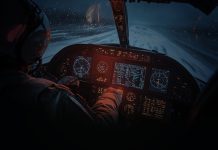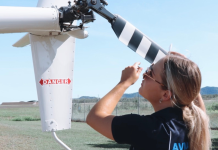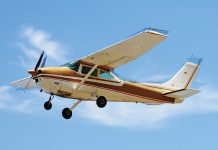On a Sunday morning in July 2023, a privately owned Bell 206B-1 helicopter was about to fly from a farm near Tumbarumba on the western side of the NSW Snowy Mountains to Khancoban, about 30 nautical miles south. Its owner/pilot and 3 passengers were onboard.
The helicopter stood on a concrete pad, nose facing the hangar from which it had been removed. The flight would be the third time the pilot had taken-off from that helipad in that helicopter but the first time with more than 2 occupants. The pilot briefed the passengers on seatbelt wear and gave an extra briefing to the front left seat passenger on the importance of not touching the anti-torque pedals. The passenger, who had flown in that seat before, indicated they understood.
The pilot brought the helicopter into a hover 7 feet above the helipad before making a hovering turn to the left for departure. After 90 degrees, there was a shudder and the helicopter began to rotate to the right. This uncommanded pirouette went on for 2 rotations as the pilot made pedal inputs without success. The pilot lowered the collective and closed the throttle as the helicopter settled. The left skid broke off on contact with the ground and the helicopter rolled onto its side.
Although it was substantially damaged, no-one was injured. The multi-point harnesses and pilot’s helmet (which sustained a deep scratch) had done their job. There was no fire and the Australian Transport Safety Bureau (ATSB) found no pre-existing flaws in the helicopter’s engine, controls or rotors.
Slip of the pen
The accident had been made more likely by a single calculation error the pilot had made in planning. The pilot had intended to convert the 430 pounds of Jet A1 in the helicopter’s tanks into kilograms but instead, converted it to litres. The pilot then converted the resulting figure of 195 into kilograms, coming out falsely at 156 kilograms, 39 kilograms below the actual fuel weight of 195 kilograms.
The pilot then reviewed these calculations using an app, iBal Rotary, which was not approved by CASA. The helicopter was a former Australian Army Bell 206B-1 Kiowa rather than a civil version of the Bell 206, and its precise specifications were not in iBal. As a workaround, the pilot selected a representative version of the type and added an imaginary 100 kg passenger in the centre rear seat to give a margin for uncertainty in the result.
The app indicated that the weight and balance of the selected model, which did not reflect the limits specified in the flight manual, was within limits. Contacted later, the app developer said the Bell OH58 A/C, a version of the Bell 206 used by the US Army, would have been a closer match. Putting the mistaken 156 kg figure for that day’s flight into the OH58 A/C model would have raised a flag that centre of gravity was forward of the limit. With the correct 195 kg figure, the virtual OH58A/C model would have declared the aircraft overweight.

Tail rotor traitors: Loss of effectiveness culprits
- Vortex ring: Crosswind or sidewards flight traps air at the tail
- Weathercock: Wind from behind pushes the tail
- Main rotor vortex: Main rotor wash hits the tail rotor
- Precessional flapping: High yaw rates reduce tail rotor thrust
- High weight: Overloading strains tail rotor
- High density altitude: Thin air lowers tail rotor efficiency
- Ground vortex: Rotor wash bounces off the ground
- Directional margin: Right wind limits left pedal
- Governor droop: Rotor RPM lag reduces thrust
- Low airspeed: Less stable in yaw
Over the limit
In any aircraft, excess weight means greater stress on the engines, wings and airframe, along with reduced margins of performance.
Instead of being 27 kg under maximum take-off weight (MTOW), the helicopter was 15 kg over.
This may not seem like much but helicopters are more immediately subject than fixed-wing aircraft to the effects of excess weight. Pilots flying overweight aeroplanes sometimes disguise and psychologically deny the condition by longer take-off rolls, higher rotation speeds and faster approach and landing speeds, all of which bring additional dangers of their own.
Helicopters do not have these reality obscuring options: a common accident profile for an overweight helicopter is a shudder, signifying loss of main rotor RPM and lift, upon the transition from flight in-ground effect to out-of-ground effect. This is followed, a few unpleasant seconds later, by impact with land or water.
Overweight conditions of less than 20 kg have been demonstrated to cause helicopter crashes by this means. One happened to a Robinson R44 in the Kimberley region of Western Australia in 2022. The combination of MTOW being exceeded and high-density altitude (involving mountain and or hot conditions) is particularly effective at dropping helicopters out of the sky with minimal warning.
The Tumbarumba accident involved a more subtle mechanism. The Bell 206 flight manual identifies 10 factors that can lead, singly or in combination, to loss of tail rotor effectiveness. Several of these factors involve winds, which were not present at Tumbarumba that morning.
The ATSB investigation focused on gross weight and a variation on ground vortex interference – helicopter-building interference.
Helicopter-building interference
In any wing, be it fixed or rotary, some air will flow upwards over the tip and curl into a vortex. In helicopters, this tip vortex becomes stronger when hovering near the ground or a wall, fence or cliff. This is because these surfaces prevent air flowing away from the rotor and direct it back into the rotor. This aerodynamic trap was responsible for the crash of a helicopter during the 2011 US Navy raid on terrorist Osama bin Laden’s hideout when it hovered near a wall that was taller than estimated in the reconnaissance.
The phenomenon is also known as recirculation and is a form of vortex ring state. (Another form of this phenomenon can occur in free air when the slower moving inner section of the rotor stalls and produces vortexes that migrate outwards along the rotor blades).
The ATSB concluded there was insufficient evidence to support other potential reasons for the unanticipated right yaw. ‘It was likely that, as the left turn brought the tail rotor closer to the hangar, with recirculation strengthened by the high all-up weight, the flow of air through the tail rotor became disturbed. As a result, a loss of tail rotor effectiveness occurred, and the helicopter began to yaw right,’ the report said.
The pilot’s miscalculation, and ill-placed faith in an app for checking it, can be seen as latent failures of accident defences – holes in the Swiss cheese, in the late James Reason’s memorable metaphor – as was the pilot’s varied pedal inputs during the rotations, rather than consistent left pedal input prescribed by the aircraft flight manual. However, the pilot’s decision to wear a helmet and the harnesses worn by all onboard, represent solid countermeasures which limited the crash’s consequence.





